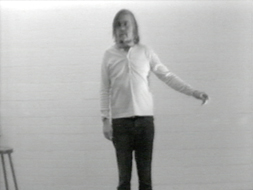 |
|
 |
John Baldessari, I Am Making Art (1971)
Courtesy of Electronic Arts Intermix (EAI), New York |
|
Bruce Nauman, Slow Angle Walk (Becket Walk) (1968)
Courtesy of Electronic Arts Intermix (EAI), New York
© Bruce Nauman / ARS, New York / SPDA,
Tokyo, 2009 |
|
|
A primary premise behind "Waiting for Video," co-curated by Kenjin Miwa and Mika Kuraya (both of the National Museum of Modern Art, Tokyo), is the crucial role that video and later film and digital media have played in the development of a postmodern or contemporary aesthetic. Consequently, while not overbearing, the exhibition is heavily weighted towards a presentation of works created nearly 40 years ago both inside and outside of Japan. Though the exhibition title suggests a particular medium -- video -- the curators consider the word in more general terms as encompassing a relatively young form of self-reflective visual art practice. Situated at the nexus of a transition from media-specific practice, video, it is suggested, allowed artists an opportunity to capture and consider their varied interests and efforts in a manner heretofore unavailable. The commercial availability of video recording devices was perfectly timed to complement a fracture in the practice of art, while newly available digital media presently serve to further complicate the act of looking within a contemporary context.
A primary example and the first work one encounters at the exhibition is artist John Baldessari's video of 1971, I Am Making Art. In this lengthy (18:40) piece Baldessari performs a series of mundane gestures before the camera, all the while proclaiming in a deadpan tone, "I am making art." A self-evident statement literally embodied in Baldessari's actions, I Am Making Art readies the viewer for several rooms' worth of recorded actions grouped thematically into categories such as "The Dematerialization of Art" and "Mirror and Reflection." While Baldessari's work may have been directly and humorously addressing a tendency of his time -- that of artists to foreground body as media -- it serves as well as an example of how such an act may expand contemporary considerations. Of equal interest is the collaborative video Image of Image: Seeing, executed by Saburo Muraoka, Tatsuo Kawaguchi and Keiji Uematsu in 1973. Throughout the course of this 12:30 piece, the subject, a television, is subjected to any number of experimental actions, among them painting, burial and physical force. In what amounts to a self-referential comedy (not unlike contemporaneous works by American artist Bruce Nauman, also featured in the present exhibition), Seeing suggests limits beyond the mediated image/action. Of a similarly lo-fi yet decidedly more current vocabulary is the work of younger Japanese artist Taro Izumi, whose series of films incorporate installation as intervention and critique. Comprised of relative one-liners such as a television image enhanced by an awkwardly placed jar of water, as well as more complex works such as Back Hand, Hand's Back, a multiple point of view journey, Izumi utilizes not only the presentational equipment on hand but also a portion of a previously functional museum wall, re-christened art object through a violent yet ultimately liberating act of re-contextualization. Further suggesting the transformative possibilities of contextual confusion is one of the final works on view, Francis Alÿs's exhibited documentary Cuando la fémueve montañas (When Faith Moves Mountains), which recounts a now legendary cooperative action orchestrated by the artist and a group of volunteers.
This brief review only mentions a small number of the countless seminal historical and more recent works on view in what amounts to an extremely relevant exhibition. Installations and discrete works by the likes of Dan Graham, Robert Smithson, Dara Birnbaum and Kohei Kobayashi -- to name a few -- are seldom presented within such a comprehensive and carefully considered environment in an institutional setting in Japan. Consequently, "Waiting for Video" both demands and rewards repeated viewings throughout the fortunately lengthy exhibition period.
|
 |
|
 |
Robert Smithson, Spiral Jetty (1970)
Courtesy of Electronic Arts Intermix (EAI), New York
© Robert Smithson / VAGA, New York / SPDA, Tokyo, 2009 |
|
Vito Acconci, Centers (1971)
Courtesy of Electronic Arts Intermix (EAI), New York |
|
|
|
 |
|
Francis Alÿs (in collaboration with Rafael Ortega), The Rehearsal I (1999-2004)
Courtesy of the artist and Galerie Peter Kilchmann, Zurich |
|